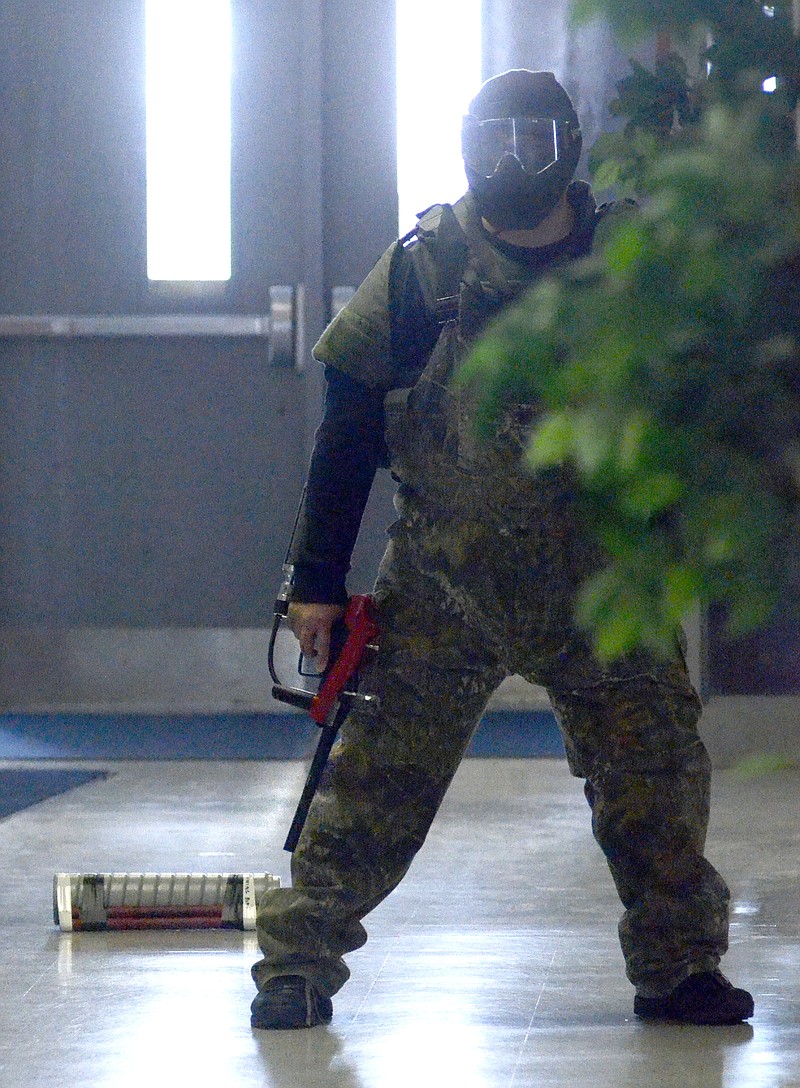Pop. Pop. The unfamiliar, yet frightening sound echoed around a hallway corner.
Seconds later a figure in camouflage overalls and a dark stocking cap runs around that corner.
Time passes - only seconds, but with adrenaline kicking in and the unknown growing wider.
Then, the call comes over the Cole County Sheriff's Department radio, during an active shooter simulation Saturday at Cole County R-I High School.
The scenario played out that the School Resource Officer was down by the armed intruder. After three-hours of classroom training and cognitive preparation, the sheriff's department was conducting a hands-on, First Officer Engage training.
The local department is believed to be the first in Missouri to formally embrace the individual training, which emphasizes rapid deployment of law enforcement.
At Russellville High School, a single deputy armed with compressed air pellets pursued the mock intruder, rather than waiting for a SWAT team or other backup.
"Every second you delay is potentially a higher body count," said Sheriff Greg White. "We're in the business to save lives."
The swifter response is contrary to tactical logic, White noted.
"We cannot have our citizens exposed to a killer, while deputies are outside waiting for backup," he said.
Not waiting for backup and having the first officer respond has been part of the department's standard operating procedure for nearly eight years. This training is taking that commitment to the next level, a press release said.
Although this scenario posed that the school resource officer already was down, Cole County schools, including Blair Oaks and Eugene, have such officers to create a law enforcement presence.
Like Joey Matherne, who posed as the intruder for the Saturday exercise, the school resource officers are expected to be competent and tactically sound, in addition to their other relationship-building and instructional duties, White said.
Saturday's training also emphasized the value of the Missouri Office of Homeland Security's ERIP (Emergency Response Information Portal) to assist responding law enforcement. Reserve Deputy Brad Spicer designed the program, which provides school details in advance for such an emergency.
Architectural barriers are the first line of defense against those who might do harm, White noted.
For example, each classroom door should have a deadbolt inside, which would at least delay an intruder.
"Lives are saved every second the intruder is slowed down," White said.
The department also works with schools to develop intruder drills, similar to those for tornado or fire threats.
Just as Saturday's training served as a "stress innoculation" to help officers keep their adrenaline and mind in check during a response, so the school drills help build resiliency in the students and teachers, Spicer said.
The department's commitment in active shooter response is based on priorities of life - innocent people first.
National statistics suggests one life could be lost to an armed intruder every 4.5 seconds.
This training will help deputies to respond as they've been trained and to be able to think through their best approach, if they were to be called to such a situation.
As law enforcement trains to increase response time, the responding officer's personal risk also increases.
Choosing to commit to engage an active shooter is a much different response than reacting to an immediate threat posed at him directly, Spicer pointed out.
"We're protectors," White said. "We step between predators and our loved ones - who can be the citizens we're sworn to defend.
"It's an awesome responsibility."

